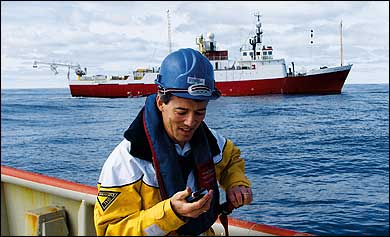“WHAT THE ICE GETS, IT KEEPS,” said Irish polar explorer Sir Ernest Shackleton—ruefully, one imagines. In 1914, Shackleton set out with a crew of 27 men to become the first to cross Antarctica, the last big polar prize, only to have a gale lodge his ship, the Endurance, in the ferocious mass of ice that swirls in a vortex atop the Weddell Sea. Over a span of ten months, the pack carried the ship 570 miles before sinking her on November 21, 1915.
What followed was a legendary saga that in recent years has been celebrated in more than a dozen books, four films, and an immensely popular exhibit at the American Museum of Natural History, in New York. The men drifted for five and a half months on the shifting ice before landing on barren Elephant Island; from there Shackleton and five others made an 800-mile crossing of the South Atlantic in a 22-foot open boat, followed by a mountainous traverse of South Georgia Island to a Norwegian whaling station. When Shackleton finally sailed back to retrieve the rest of the crew—miraculously, all survived—nine months had passed since the Endurance went down. Now, 90 years later, two British syndicates are in a race to find the wreckage of the Endurance, and see if the ice might relinquish some of her after all. Both teams plan to set sail in the austral summer, possibly as soon as 2004-05, and once on site—about 1,100 miles south of Cape Horn, at 68°5′ south, 52°5′ west—they’ll use sonar, magnetic sensors, and remote-operated vehicles (ROVs) mounted with cameras to locate the ship’s remains, some 10,000 feet below the surface.
Numerous vessels have been discovered at similar depths, but rarely in a spot as remote, and never beneath a shifting plain of six-foot-thick ice. The mission will cost upwards of $5 million, so it’s likely that only one team will raise enough money to pull it off. Right now the expeditions are locked in a fierce battle—playing out in corporate board rooms, museum offices, and the cocktail circuit—for cash and credibility.
Given the possibility that the ship is now little more than smashed timber, some Shackleton historians wonder if it’s worth all the trouble. “I’m not sure what the mystery is,” says Caroline Alexander, author of the 1998 bestseller that sparked Shackletonmania, The Endurance: Shackleton’s Legendary Antarctic Expedition. “Usually when you search for a lost ship, there’s something you want to know. We have film of her death agony and know everything that was on board. They may find some souvenirs, but I’m not sure we’ll learn very much.”
Maybe, but a shot at uncovering Endurance relics has attracted some of the biggest players in deep-sea exploration. “This will be one of the most ambitious searches ever,” says David Mearns, 45, the director of Blue Water Recoveries, a UK-based underwater-survey-and-salvage company. “I expect there will be quite a bit of the ship left. We would like to rediscover the lost science. There was a tremendous amount of samples and instruments left behind.”
On the strength of his résumé and progress with sponsors, Mearns is the race’s clear front-runner. He’s found some 50 deep-water wrecks, including the WWII battle cruiser HMS Hood, which, in 2001, he uncovered 9,200 feet below the Denmark Strait (between Greenland and Iceland) in just 39 hours. To find the Endurance, he’s won the support of the British Antarctic Survey, the Royal Navy, and as-yet-unnamed corporate donors. As of early October, Blue Water was in advanced discussions with Mearns’s first-choice media partner, the Washington, D.C.-based National Geographic Society.
The rival team is co-led by Scottish adventurer Jock Wishart, 46, and Jonathan Adams, 52, director of the Centre for Maritime Archaeology at the University of Southampton. Wishart has rowed the Atlantic, hiked to the magnetic North Pole, and, in 2001, re-created Shackleton’s traverse of South Georgia Island. In 1982, Adams accomplished one of the most notable feats in modern nautical archaeology when he raised King Henry VIII’s Mary Rose, 437 years after it disappeared. Besides hunting for the Endurance, the duo plans to search for the Antarctic, a Swedish shipwreck from 1903, and complete a scientific survey of the Bransfield Strait. “It’ll be the largest British-led scientific expedition in five decades,” says Wishart, who declined to name prospective funders, saying only that two are UK oil companies.
To win the money round, the rivals have embraced clashing tactics. While Mearns has toiled quietly to get all his ducks in a row, the Wishart-Adams camp has chosen a more PR-hungry approach, announcing expedition plans to the British press last spring and now attempting to sow doubt about Mearns’s qualifications. Exploiting a major rift in oceanographic circles—crudely put, the scientists versus the salvagers—they’re suggesting that Blue Water’s past for-profit salvaging projects make the company unfit for a role in such a historically significant endeavor. Asked if he’d ever considered collaborating with Blue Waters, Wishart said Mearns’s reputation as a salvager made that unthinkable: “He’s very capable, but we can’t, as a scientific expedition, bring him on board or our code of ethics would go right out the window.”
Mearns hotly denies that he’s mercenary. “Nothing could be further from the truth,” he says, citing plans to mount an exhibition with any Endurance finds at the National Maritime Museum, in Greenwich, England. He has also signed a legal agreement with Shackleton’s granddaughter Alexandra that grants him the right to recover artifacts on behalf of the family, and guarantees that everything will be properly preserved.
For all the hustling, what do they stand to find? The biggest prize is a small selection of glass-plate photos left behind by expedition photographer Frank Hurley when the crew abandoned ship. Shackleton supposedly told Hurley to break 400 plates so he wouldn’t be tempted to go back for them, but Shane Murphy, 56, an amateur historian who’s transferred all of Hurley’s diaries onto CD, insists that “if Hurley had a good photo, he wouldn’t have destroyed it.” (Though the Weddell Sea might have—the plates’ emulsion makes a fine meal for seaborne bacteria.)
Wishart, Adams, and Mearns aren’t the first to announce plans to find the Endurance. In 2001, Robert Ballard, the Mystic, Connecticut-based explorer who found the Titanic, proclaimed his intentions but failed to raise enough cash. The same could happen for these two, though for now both teams are confident. “There are very few truly virgin seas,” says Mearns. “We will be the first ever to go to the bottom of the Weddell, and that’s part and parcel with what Shackleton was doing when he was there.”
Endurance Rush
Two rival British teams launch a tenacious race to find Shackleton's long-lost ship

(Photo: Rob White)
New perk: Easily find new routes and hidden gems, upcoming running events, and more near you. Your weekly Local Running Newsletter has everything you need to lace up! .
From ���ϳԹ��� Magazine, Dec 2003
Lead Photo: Rob White

